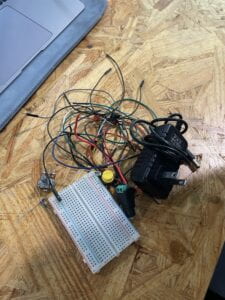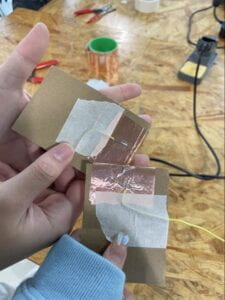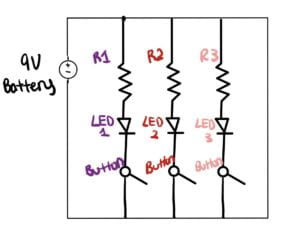During the first recitation, I successfully collaborated with Jessie to create a working circuit!

As someone who has never experimented with wires or robotics equipment before, this task seemed daunting at first glance. Creating a functioning circuit from scratch that used electricity terrified me, both physically and mentally. All I had in front of me was a breadboard, yellow push-button switch, several colorful jumper cables, resistors, 2 LED lights, and my wonderful partner.
Eventually, through trial and error, we were able to complete step one. The buzzer failed to work in the beginning, because of mistakes in the wiring work. After consulting Corrina (Learning Assistant), she brilliantly helped us rearranged the wire which resulted in the buzzer sounding. It was a slow start, but progress was definitive.
At this stage, we’ve completed part 2. The previous wires had allowed electricity to flow through the buzzer into the button. A resistor was placed to stabilized the electricity flow. To make it more function-able, we’ve added an light blue LED light. I learned more in depth about how separate components paired together to focus on a task. Now, our craft started to take its initial form.

While in the process of deciphering part 3, our entire table was called to the other side of the room. Professor Minsky then briefly taught us how to solder. It looked dangerous and nearly impossible, but I was quite satisfied with the product (paddle-switch made from cardboard, tape/copper tape, jumping cable, etc.)! I still need to work on my soldering skills, but I’m confident there will be plenty of additional practice ahead.
In the end, our finished product looks like this! We’ve added alot more wires, a variable resistor, a new red LED night, and the paddle-switch. Following the tutorial, we connected the two separate paddle switches together via tape. This entire learning/hands-on process taught me to be resilient and persevere. While we received occasional assistance from Corrina and Iris (IMA Fellow), we worked independently for the majority of it.
Personally, this learning curve was challenging yet rewarding. Building a complete gadget from scratch, and realizing your hard work paid off releases a immense amount of dopamine. Though this project has its flaws and unique look — it served its intended purpose! I truly enjoyed this recitation, as I feel a sense of fulfillment upon completing the assignment. I thank my partner and look forward to the next project!
Questions:
Question 1: R1’s function is to limit and stabilize the current & voltage that the LED generates. Light Emitting Diodes (LED), when connected to a source, typically generates as much power as possible. However, this is extremely harmful and could potentially destroy the device. In a real-life scenario, R1 serves as a close-friend who calms the red LED down during a heated argument and allows it to relax.
Question 2:

Question 3:After reading the article, we can interpret that the circuit we built also includes interactivity. The articles lists three separate factors: listening, thinking, & speaking. Only when these elements are combined, does the concept of interactivity fully emerge itself. I think of the interactivity as the connection between the paddle-switch, LED light, and buzzer. When the paddle switch is clapped together, the circuit itself starts thinking. As the electricity current streams down, it tells the buzzer and LED light what to do. Finally, the LED light speaks by lighting up, while the buzzer speaks by literally buzzing. In this process, all three factors of ‘interactivity’ are demonstrated.
Question 4: Interaction Design and Physical Computing be used to create Interactive Art due to the beautiful aspect of human creativity and the use of mechanic devices. According to Google, physical computing involves interactive systems that can sense and respond to the world around them. When a creator implements their ideas into a device, interactive art seemingly comes to life. An example I would like to use is my favorite movie character BayMax, an robot from Big Hero Six. The movie documents the process of how interaction design combined with physical computing (Interactive Art) can benefit the world, but simultaneously possesses the power to destroy it. Additionally, Zach Lieberman is a inventor who designed a device called Eyewriter. This device tracks the users’ eye movement, resulting in the ability to write/draw on a computer screen. It allows paralyzed artists, graffiti artists, and anyone looking to draw/write in general to communicate their opinions. Therefore, I believe that interactive art is beautiful and can be helpful to society in limitless ways.

Leave a Reply